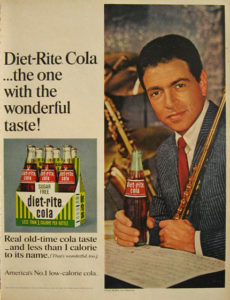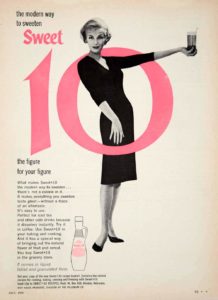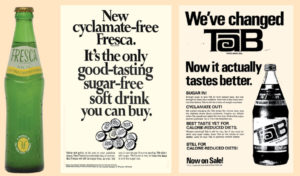
In 1937, Illini graduate student Michael Sveda was working on trying to synthesize an anti-fever medication. Like all health-conscious individuals of the era, he was having a smoke whilst working. Laying it on the table for a bit, he picked it up and was surprised that the tip tasted quite sweet. That taste prompted him to do more research and seek a patent.
Eventually, he sold the patent to DuPont, which sold it to Abbott Laboratories. Abbott saw commercial potential to using the product as a low-calorie sweetener. So they went through the laborious process of getting FDA approval, and obtained said certification in 1950.
Initially, Cyclamate was prescribed as a drug for the obese. In 1958, it received approval as a food additive. By 1960, a sweetener called Sweet*10 was a big hit in the US. It would make food, drinks, etc. sugary sweet with practically no calories!
What’s not to love?
Soon, Cyclamate was used for sweetening a host of products. Canned fruit, Jell-O, Funny Face drink mixes, and sugar-free candy were among the plethora of products that weight-conscious consumers, each having a sweet tooth, purchased by the boatload.
Moms loved it. The sugar rush that THEIR moms had long put up with from their children was now a thing of the past! Kids could drink a whole pitcher of sugar-free Kool-Aid and not be wired to the gills!
Not only that, but those same moms could enjoy a very sweet cup of coffee or glass of tea and not worry about the pounds that were being added to their frames.

In 1963, Coca-Cola introduced a Cyclamate-sweetened drink called Fresca. I loved it at first taste, and my mom was happy to see me taking in less sugar. Believe me, I was already wired enough!
Again, what’s not to love?
Enter FDA scientist Jacqueline Verrett. In 1969, she appeared on NBC’s Huntley-Brinkley Report with photographs of malformed chicks who had been injected with large quantities of Cyclamate. The images were shocking, and viewers were immediately filled with doubts about the safety of the low-calorie foods that they had been scarfing down.
A few days later, a study was released (from Abbott Laboratories themselves) that showed that eight out of 240 rats that had been fed the equivalent of 350 cans of soda a day had developed bladder cancer.
Interestingly, the study involved feeding the rats both Cyclamate AND saccharine. The results weren’t blamed on one sweetener over the other.
Anyhoo, the FDA reacted with a ban on Cyclamate on October 18, 1969. It completely caught the food industry off-guard.

Soft drink manufacturers scrambled to come up with another sugar-free solution. The most obvious, saccharine, left a bitter aftertaste that turned this life-long Fresca drinker into a Squirt fan. Funny Face started telling consumers that they would need to add sugar to their mixes (they did drop the price from 10 cents to a nickel for the trouble). Some added sugar (in smaller quantities) to their formerly Cyclamate-sweetened products. One bizarre example of spin was done by Coke with Tab. A TV commercial I remember well used a song to inform the public that Tab used sugar in order to taste better than it would have with saccharine. The tag line? “Tab tastes good enough for GUYS!”
I’ll bet Gloria Steinem loved that.
Nowadays, we have Splenda to sweeten our diet drinks with no discernable aftertaste in the US. Hooyah, I’m drinking Fresca again! But in many industrialized nations, Cyclamate is still used. And no, bladder cancer rates (or any other of the other bad stuff that Cyclamate was accused of causing) aren’t any higher than over here. The Cyclamate ban probably hurt the process of the banning of dangerous substances as a whole, simply because of the backlash that came from the public after learning of the truly astronomical amounts of the substance that test animals were given. Heck, Verrett’s baby chicks would have looked like crap if they had been force-fed that much WATER!
But, for better or worse, it happened. And it’s a memory that we Boomer kids can recall if we try, again, for better or worse.